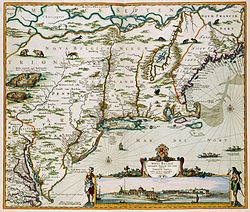New Netherland Nieuw Nederland | |||||||||||||||||||
|---|---|---|---|---|---|---|---|---|---|---|---|---|---|---|---|---|---|---|---|
| 1614–1667 1673–1674 | |||||||||||||||||||
 New Netherland map published by Nicolaes Visscher II (1649–1702) | |||||||||||||||||||
| Status | Colony (Dutch colonial empire) | ||||||||||||||||||
| Capital | New Amsterdam | ||||||||||||||||||
| Official languages | Dutch[1][2] | ||||||||||||||||||
| Minority languages | Low Saxon, French, English, Algonquian, Delaware | ||||||||||||||||||
| Religion | Dutch Reformed[3] | ||||||||||||||||||
| Demonym(s) | New Netherlander New Dutch | ||||||||||||||||||
| Government | Self-governing colony | ||||||||||||||||||
• Director | (List) | ||||||||||||||||||
| Establishment | |||||||||||||||||||
• Establishment of the first settlers | 1614 | ||||||||||||||||||
| August 27, 1664 | |||||||||||||||||||
| July 23, 1667 | |||||||||||||||||||
| August 9, 1673 | |||||||||||||||||||
| February 19, 1674 | |||||||||||||||||||
| Population | |||||||||||||||||||
• Estimate | 350 (in 1630)[4] 4,301 (in 1650)[4] 9,000 (in 1674) | ||||||||||||||||||
| Currency | Dutch rijksdaalder, leeuwendaalder | ||||||||||||||||||
| |||||||||||||||||||
| Today part of | |||||||||||||||||||
| New Netherland series |
|---|
| Exploration |
| Fortifications: |
| Settlements: |
| The Patroon System |
|
| People of New Netherland |
| Flushing Remonstrance |
 |
New Netherland (Dutch: Nieuw Nederland) was a 17th-century colonial province[5] of the Dutch Republic located on the East Coast of what is now the United States of America. The claimed territories extended from the Delmarva Peninsula to Cape Cod. Settlements were established in what became the states of New York, New Jersey, Delaware, and Connecticut, with small outposts in Pennsylvania and Rhode Island.
The colony was originally conceived by the Dutch West India Company (GWC) in 1621 to capitalize on the North American fur trade. Settlement initially stalled because of policy mismanagement by the GWC and conflicts with Native Americans. The settlement of New Sweden by the Swedish South Company encroached on its southern flank, while its eastern border was redrawn to accommodate an expanding New England Confederation.
The colony experienced dramatic growth during the 1650s and became a major center for trade across the North Atlantic. The Dutch conquered New Sweden in 1655 but, during the Second Anglo-Dutch War, surrendered New Netherland to the English following the capture of New Amsterdam. In 1673, the Dutch retook the colony but relinquished it under the Treaty of Westminster (1674) that ended the Third Anglo-Dutch War.
The inhabitants of New Netherland (New Netherlanders) were European colonists, Native Americans, and Africans imported as slave laborers. Not including Native Americans, the colonial population, many of whom were not of Dutch descent,[6][7][8] was 4,301 in 1650[4] and 8,000 to 9,000 at the time of transfer to England in 1674.
Cite error: There are <ref group=nb> tags on this page, but the references will not show without a {{reflist|group=nb}} template (see the help page).
- ^ "The New Netherland Dutch". The People of Colonial Albany live here. February 2003. Archived from the original on March 3, 2016. Retrieved December 8, 2008.
- ^ Shorto, Russell (November 27, 2003). "The Un-Pilgrims". The New York Times (New York ed.). p. 39. ISSN 0362-4331. Retrieved March 6, 2009.
- ^ Wentz, Abel Ross (1955). "New Netherland and New York". A Basic History of Lutheranism in America. Philadelphia: Muhlenberg Press. p. 6.
- ^ a b c Cite error: The named reference
popstatswas invoked but never defined (see the help page). - ^ "P. Geyl, Geschiedenis van de Nederlandse stam · DBNL".
- ^ Peter Eisenstadt, ed. Encyclopedia of New York State (Syracuse UP, 2005) p. 1051.
- ^ Scheltema, Gajus and Westerhuijs, Heleen. Exploring Historic Dutch New York, 2013.
- ^ Oliver A. Rink, Holland on the Hudson: An Economic and Social History of Dutch New York, Ithaca, NY: Cornell University Press, 1986, p. 156.

![Seal[nb 1] of New Netherland](http://upload.wikimedia.org/wikipedia/commons/thumb/5/5f/Seal_of_New_Netherland_%28Sigillum_Novi_Belgii%29_Bronze_Cast_Iron.png/85px-Seal_of_New_Netherland_%28Sigillum_Novi_Belgii%29_Bronze_Cast_Iron.png)